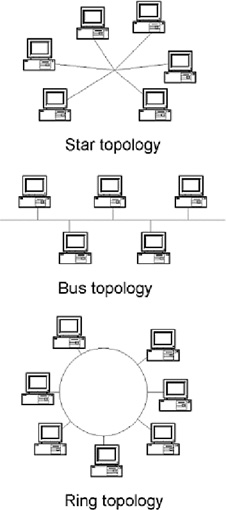
Industrial Network Components
In larger industrial and factory networks, a single cable is not enough to connect all the network nodes together. We must define network topologies and design networks to provide isolation and meet performance requirements. In many cases, because applications must communicate across dissimilar networks, we need additional network equipment. The following are various types of network components and topologies:
Network Topology
Industrial systems usually consist of two or more devices. As industrial systems get larger, we must consider the topology of the network. The most common network topologies are the bus, star, or a hybrid network that combines both. Three principal topologies are employed for industrial communication networks: star, bus, and ring as shown in Figure 3.
A star configuration contains a central controller, to which all nodes are directly connected. This allows easy connection for small networks, but additional controllers must be added once a maximum number of nodes are reached. The failure of a node in a star configuration does not affect other nodes. The star topology has a central hub and one or more network segment connections that radiate from the central hub. With the star topology, we can easily add further nodes without interrupting the network. Another benefit is that failure of one device does not impair communications between any other devices in the network; however, failure of the central hub causes the entire network to fail.
In the bus topology, each node is directly attached to a common communication channel. Messages transmitted on the bus are received by every node. If a node fails, the rest of the network continues in operation as long as the failed node does not affect the media.
In the ring topology, the cable forms a loop and the nodes are attached at intervals around the loop. Messages are transmitted around the ring passing the nodes attached to it. If a single node fails, the entire network could stop unless a recovery mechanism is not implemented.
For most networks used for industrial applications, we can use hybrid combinations of both the bus and star topologies to create larger networks consisting of hundreds, even thousands of devices. We can configure many popular industrial networks such as Ethernet, FOUNDATION Fieldbus, DeviceNet, Profibus, and CAN using hybrid bus and star topologies depending on application requirements. Hybrid networks offer advantages and disadvantages of both the bus and star topologies. We can configure them so failure of one device does not put the other devices out of service. We can also add to the network without impacting other nodes in the network.